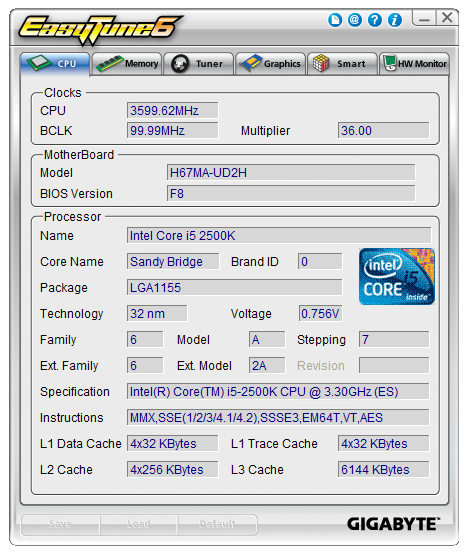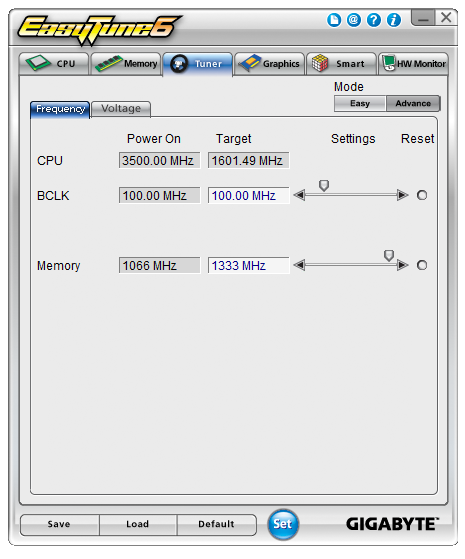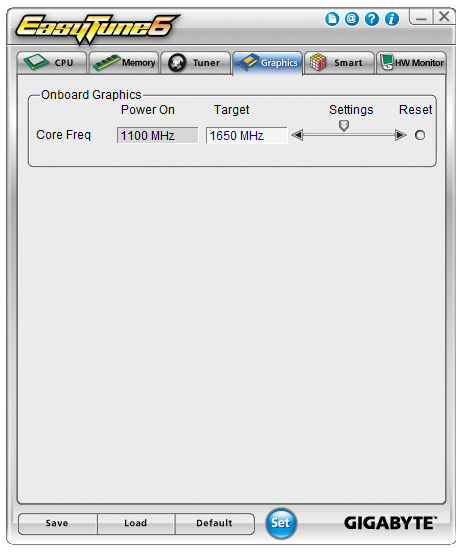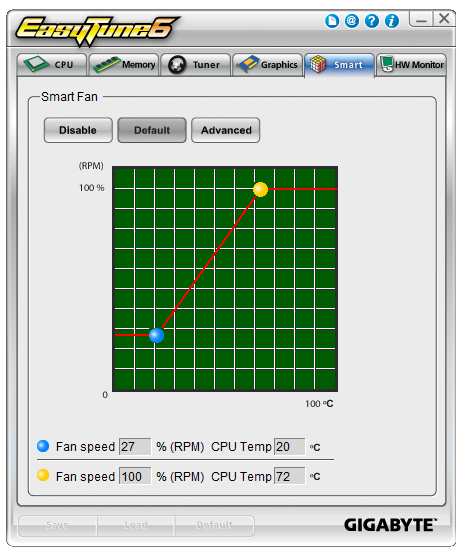H67 – A Triumvirate of Tantalizing Technology
by Ian Cutress on March 27, 2011 6:25 PM EST- Posted in
- Motherboards
- Sandy Bridge
- H67
Board Features
| Market Segment | Mainstream H67 |
| CPU Interface | LGA 1155 |
| CPU Support | I3/i5/i7 Sandy Bridge |
| Chipset | H67 |
| Base Clock Frequency | 100 MHz |
| DDR3 Memory Speed | 1333 MHz, CL9 9-9-24 |
| Core Voltage | 0.750 V to 1.795V in 0.005 V increments |
| CPU Clock Multiplier | Dependant on CPU |
| DRAM Voltage | 1.100 V to 2.400 V in 0.020 V increments |
| DRAM Command Rate | Auto, 1T to 3T |
| Memory Slots |
Four 240-pin DDR3 DIMM slots in dual-channel Regular unbuffered DD3 memory Up to 32GB total supported |
| Expansion Slots |
1 x PCI Express 2.0 x16 slot 2 x PCI Express 2.0 x1 slots 1 x PCI Express 2.0 x4 slot (electrical) |
| Onboard SATA/RAID |
2 x SATA 6 Gb/s ports (white) 3 x SATA 3 Gb/s ports (blue) 1 x eSATA 3 Gb/s port |
| Onboard |
2 x SATA 6 Gb/s ports 3 x SATA 3 Gb/s ports 2 x Fan Headers 1 x Front Panel Header 1 x Front Panel Audio Header 1 x S/PDIF Out Header 1 x Serial Port Header 5 x USB 2.0 headers supporting 10 USB 2.0 ports |
| Onboard LAN | Gigabit Ethernet, powered by the Realtek RTL8111E |
| Onboard Audio | Realtek® ALC892 7.1-Channel HD Audio |
| Power Connectors |
24-pin EATX Power connector 8-pin EATX 12V Power connector |
| Fan Headers |
1 x CPU Fan connector (4-pin) 1 x System Fan connector (3-pin) 2 x USB 3.0 ports (blue) |
| I/O Panel |
4 x USB 2.0 Ports 1 x D-Sub 1 x HDMI Port 1 x DVI Port 1 x Display port 1 x RJ45 LAN connector 1 x Audio port (Line-in,4x Line-out, SPDIF out) 1 x eSATA 3Gb/s port |
| BIOS | Dual BIOS system, F8 |
No Power/Reset buttons, no Debug LED, no dual gigabit Ethernet (like the ECS board), and a lack of fan headers, but we do have the Dual BIOS system which Gigabyte stick to every board.
In The Box
- 4 Locking SATA cables, 2 of them right angled
- Support CD
Not a lot comes with the H67MA-UD2H, which is a bit disappointing given what comes with the ASRock at a similar price point.
Software
As with the P67A-UD4 we have already reviewed, the software is pretty much the same, apart from minor adaptations for the H67 chipset. I found it mildly amusing that during the standard driver install on the disk, it quoted me 490 minutes for a full install – in reality it took less than five, but it brings me memories of the old Windows ‘time to finish’ function.
EasyTune6

The front screen on EasyTune this time gives the CPU data, as well as the Motherboard model and BIOS version. Previously we saw an ‘easy OC’ screen on EasyTune, and we do not get one here for GPU overclocking.

The more intricate overclocking screen for EasyTune is still present though – in Advance mode, we have options to adjust the BCLK and the Memory; however the memory is limited to the 1333 MHz divider, as per H67 specifications. Any changes to the BCLK require the ‘Set’ button to be pressed and a reboot. The voltage screen is essentially similar to the options you get in the BIOS.

Rather than keep all the OC options on one screen, or recreate them to make them all on one screen, the integrated GPU overclocking options are in the graphics section only. Another slider bar and this one goes all the way up to 3000 MHz in 1 MHz divisions.

The fan controls are straight forward, given that there is only one fan you can control.
Smart6
Smart6 is identical to previous versions so I will not repeat it here, but QuickBoost in this iteration does not do anything, as there is no CPU overclocking on this board.











56 Comments
View All Comments
james.jwb - Sunday, March 27, 2011 - link
"However, I remember the time when I was a scrimping student. I wanted high gaming performance at the lowest cost – if Sandy Bridge was out then, and I was specifically after the Sandy Bridge platform over anything AMD, then a H67 with an i3-2100 and the biggest graphics card I could afford would be a viable option."When I was in this position, i'd go for the cheapest CPU and overclock it so it was faster than anything on the market. I'd be surprised if this wasn't the norm for people on a tight budget.
IanCutress - Sunday, March 27, 2011 - link
My argument mainly for my comment is that the CPU is becoming less of a factor for gaming, thus shifting the focus away from a CPU OC to a large GPU. It used to be the case that the CPU made a large difference as well, but it my mind it's not that much of an issue with a strong default CPU speed and cores available. Nevertheless, the AMD + cheap tri/quad core is on the other side of the coin.Ian
slickr - Monday, March 28, 2011 - link
Intel mobos are crap. Only for overclocking and only for graphics, where is the middle?And they are too expensive, hopefully AMD wipes the floor with them with their new Buldozer platform.
Jeffs0418 - Sunday, May 22, 2016 - link
Here we are 5 years later and...Y'know I was ready to move on from my Athlon 64 x2 5000+/AM2 platform(which I liked but was marginal for modern gaming). I was stoked for a nice capable FX4100/Bulldozer platform. But after reading disappointing reviews I ended up with a Core i3 2120/Sandy Bridge and a H61 mobo. Currently running a Core i5 2500(non-k) massaged a bit to 3.9GHz on all cores with aftermarket cooling on P67 mobo. Never have used Intel integrated graphics so I couldn't care less about that. But I am glad I didn't go with Bulldozer and am comfortable enough with my current setup even now that I'm in no hurry to upgrade.omelet - Sunday, March 27, 2011 - link
Wouldn't someone wanting SB gaming on a budget be more likely to want an H61? You can get such a board from ASRock for like 60 bucks. That's $60 more you'd be able to spend on the GPU, and you'd still have every feature you need. The only real performance difference is that there's no SATA 6Gbps, but budget gamers don't have drives that need that anyway.yzkbug - Sunday, March 27, 2011 - link
Totally agree. I’m looking for a good, reliable, budget-priced motherboard for my new HTPC. Would love to see a comparison review of H61 motherboards, especially the power comparison numbers.Taft12 - Sunday, March 27, 2011 - link
I'd need to know at what point the 6 PCIE lanes on H61 begins to get in the way of the GPUs performance. Someone will surely do the testing to show us in the near future. Noticeable on, say, a 6850? Or do we need a much higher-end GPU for a bottlenect?DanNeely - Sunday, March 27, 2011 - link
The GPU would still be running on the 16 lanes from the CPU. You just have 2 less lanes for 2ndary slots and onboard devices. I don't think it's likely to be an issue except in that you're much less likely to get a second x4 slot (1/11 vs 6/16 on newegg), and the 1 H61 board that does it has legacy PCI slots for the other 2 spaces, while 5/6 H67 boards have at least 1 1x slot as well.omelet - Sunday, March 27, 2011 - link
This is very confusing. All the boards claim to have x16 slots, but they can't possibly run at x16 if none of the boards on the table even have 16 lanes. A P67 running two cards would have to run each at 4x, or even lower if there are any x1 slots on the board (as there are on most boards).It might be explained as being an x16 slot running at a lower speed, except for the fact that P67 and P55 both specify that they can run two cards at x8/x8, which can only mean that they run the x16 slots at 8 lanes each when you have two cards plugged in. That should also be impossible according to the table.
Other sources I've found on the internet seem to imply that the x16 slot on the H61 runs at full x16 speed. I think perhaps we just need some clarification on what the values on the table here mean.
ajp_anton - Sunday, March 27, 2011 - link
There are two sources for PCIe lanes. The CPUs all have x16 (only for graphics), the rest (what is shown in the table) come from the motherboard chip (H67 etc).